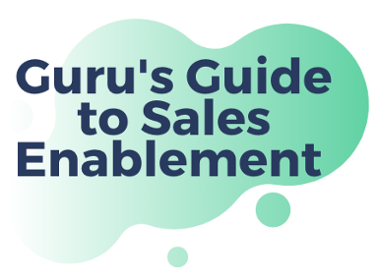How to Crush Your First 30 Days as a New Sales Enablement Hire
あなたは新しい営業支援リーダーとして雇われ、チームの営業サイクルを加速させるための手助けをします。 おめでとうございます! でも、どうすれば迅速に動き出し、最初の30日間でチームに価値を加えることができるのでしょうか?
やるべきことが山ほどあり、あちこちから引っ張られることは間違いありません。 営業支援は営業、マーケティング、プロダクトチームの中心に位置するため、これは予想外のことではありません。 したがって、成功するためには、増え続けるタスクのリストを徹底的に優先順位付けすることが不可欠です。 私たちの経験では、営業チームの日常業務に価値を追加する最も迅速な方法は、営業担当者が効果的に販売するために必要な知識をしっかりと持つことを確実にすることです。
新しいガイドで、さらに多くの営業支援のコツとトリックを手に入れましょう:

ここには、あなたが仕事を始めて最初の月に達成すべき5つのタスクがあります。これを行うことで、営業支援の達人になる道が開けます。
1. 営業、マーケティング、カスタマーサクセス、プロダクトリーダーと話す
営業リーダーからKPIと営業チームの主要な収益目標を理解することが第一歩です。 他の重要な利害関係者と連携を取ることも同様に重要です。例えば、マーケティング、カスタマーサクセス、プロダクトチームです。 営業支援の核心は、営業担当者が製品を販売するために必要なことに集中できるようにするために提供するコンテンツと知識です。 その大半は営他のマーケティング、カスタマーサクセス、プロダクトチームの助けを借りて作成されるでしょう。 したがって、初期の段階では、それぞれのリーダーと話をして過去にどのように物事が行われていたかを理解し、彼ら自身の役割を理解してもらうことが重要です。
製品、カスタマーサクセス、マーケティングリーダーに尋ねるべき重要な質問は次のとおりです:
すべてのチーム
- 営業チームに製品、メッセージング、ポジショニングの変更を通知するための主要なコミュニケーションチャネルは何でしたか?
- これらの文書、資料、知識はどこに保存されていますか?
- いつ、どのようにこれらの文書が更新され、誰がそれを担当しているのかに関する正式なプロセスはありますか?
- 営業チームから得た重要なフィードバックをどのようにあなたのチームに伝えるべきですか?
プロダクトリーダー
- 営業担当者が製品の質問を持っているとき、どこでそれを聞くのですか?
- 過剰な肩たたきや一度きりのメッセージが、あなたのチームを仕事から引き離す問題になっていますか?
カスタマーサクセスリーダー
- 顧客が期待する製品の機能は、一貫性がありますか、それとも大きく異なっていますか?
- 顧客が期待するサポートのレベルは、一貫性がありますか、それとも大きく異なっていますか?
- 新しい顧客が一貫して理解していない、または知らない機能はありますか、それが彼らの製品から最大限の価値を引き出す能力を妨げていますか?
- あなたのチームが顧客をサポートする上で直面している最大の課題は何ですか? 営業チームはそれを軽減するために何をすることができますか?
マーケティングリーダー
- 私たちの営業担当者は、一貫して最新の資料やマーケティングコンテンツをコールやメールで使用していますか?
- 私たちのマーケティングと営業チームを調整する上での主な障害は何ですか?
- マーケティングは現在、営業担当者が現場で聞いているトレンド、競合、業界の更新をどのように学んでいますか?
2. 営業担当者と話す
営業とより広範な組織間の整合性を確保することは重要ですが、営業組織内の整合性も同様に重要です。 営業リーダーシップ、中間管理職、営業担当者は同じ目標に向かって取り組む必要があります。それが正しく時間を優先する助けとなります。 営業支援リーダーとして、あなたの主要な利害関係者は毎日電話をかけるフロントラインの営業担当者です。 それぞれの営業担当者と1対1で座り、販売チームの現状についてのフィルタリングされていない意見を聞いてください。
尋ねるべき重要な質問は次のとおりです:
- 私たちの製品、営業プロセス、重要なメッセージのポイントなどに関するあなたの理解のギャップはどこにありますか?
- あなたが最も耳にする競合はどれですか?
- 最も一般的な反論は何ですか?
- 誰かに質問する必要があるとき、どこに行き、彼らが戻ってくるまでにどれくらいの時間がかかりますか?
- 見込み客から得たフィードバックを、マーケティング、製品、カスタマーサクセスなどの他のチームにどのように伝えていますか?
3. コンテンツ監査を行う
私たちが提案した2つのタスクは、すべて他者の意見を聞くことに関するものであるため、偶然ではありません。 営業リーダー、営業担当者、他の利害関係者チームと話した後、土地の良い頃合いを知ることができ、得た洞察を実行可能な項目に変換できるはずです。 その一つがコンテンツ監査です。
作成された現在の営業およびマーケティングのコンテンツをレビューしてください。 顧客の旅全体を十分にカバーできていますか? 顧客がファネルを通じて進むのを助けるために、各ステップで営業チームにコンテンツを提供する必要があります。
ここには、各ステップで作成するべきコンテンツの種類の例があります:
- 無関心: 他のベンダーからの痛みのポイントに関するコンテンツ(すなわち、業界アナリストや業界の思想的リーダー)、関連するプレスの言及
- 認識している: 業界のホワイトペーパーやアナリストレポート
- 興味: 短い製品概要ビデオ、紹介ウェビナー、あなたの会社の業界に関する独自の見解を強調するブログのリーダーシップ投稿。
- 評価: 製品の使用事例ガイド、営業プレイブックの知識(デモスクリプト、製品FAQ、競争力 POSITIONING、メールテンプレート、反論処理など)
- 決定: 業界関連の事例研究、顧客の推薦、顧客リファレンスコール
- 購入: スタートガイド、製品の展開と導入ガイド、ベストプラクティスガイド
4. すべての営業コンテンツをホストするソリューションを評価し始めてください。
営業支援の役割には、営業担当者が関連する営業資産と知識を見つけるための単一の情報源を持つことを確認することが重要です。 あなたが運営しているGoogleドライブ、ドロップボックス、内部ウィキ、あるいはSlackは、しばしば十分ではないか、または騒音が多すぎてチームの支援ニーズをサポートすることができません。 迅速で簡単に関連する営業知識にアクセスできる営業支援ソリューションを見つける必要があります。
営業支援ソリューションを評価する際に考慮すべき重要な要素は次のとおりです:
- そのソリューションは、採用しやすく、私のチームのワークフローに自然ですか?
- そのソリューションは、実行可能なビジネス成果に関する分析を提供しますか? このソリューションの使用をより早い営業サイクルに結び付けられますか? より早いオンボーディングを確保する時間は?
- 営業担当者は、そのコンテンツが最新であると信頼できますか? (だから、彼らはあなたのチームの専門家に肩たたきをする必要がありません)
- 私は、私のチームに直感的な方法で知識を整理できますか?
さらなるインスピレーションが必要ですか? さまざまなソリューションを評価する際に考慮すべき重要な質問をさらに分解した営業支援評価チェックリストをダウンロードしてください。
5. 主要なKPIをベンチマークし始めます。
新しい営業支援ソリューションの真の影響を知ることは、実装する前に主要な指標を適切に追跡していない限り、知ることはできません。 比較するための基準を持つ必要がありますので、オンボーディング時間、営業サイクル時間、競争勝率などの主要な指標に関する内部データを確認してください。 歴史的データがない場合、今がスタートを切るのに最適な時期です!
もし、最初の月にこれらの5つのタスクを達成できれば、あなたの営業支援プログラムの土台が整えられ、営業チームの効率に即座に影響を与えることができます。






